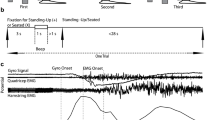Summary.
To investigate the influence of taurine and caffeine containing drinks and physical stress on the cortical movement-preparation, the readiness potentials or "Bereitschaftspotentiale" (BPs), preceding voluntary self-placed pedalling movements, were examined after different states of exhaustion on an ergometer. 15 (13 right-handed) healthy men, aged between 22–30, participated in a randomised, cross over, double-blind, placebo controlled study.
BPs were averaged out of artefact free EEG-segments from more than 90 triggered events, measured at 17 electrodes of the 10 : 20 system. With increasing effort the BPs were enlarged differently depending on the drink consumed. In placebo trials after exhaustive exercise premovement negative potential curves could be seen even in frontal areas. With caffeine the BPs increased after lower workload, achieving a level, which was reached in the placebo trials only after submaximal physical activation. Furthermore a significant shortening of premovement-brain-potentials in frontal and parietal regions could be seen in the caffeine trials at rest. Taurine admixture seems to inhibit this effects.
Similar content being viewed by others
Author information
Authors and Affiliations
Additional information
Received November 2, 1999 / Accepted February 1, 2000
Rights and permissions
About this article
Cite this article
Barthel, T., Mechau, D., Wehr, T. et al. Readiness potential in different states of physical activation and after ingestion of taurine and/or caffeine containing drinks. Amino Acids 20, 63–73 (2001). https://doi.org/10.1007/s007260170066
Issue Date:
DOI: https://doi.org/10.1007/s007260170066




